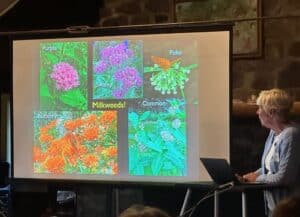Hello, fellow readers; I was honored to participate in the Women and Their Woods retreat hosted by the Ridge and Valley Conservancy in Newton, NJ, to help landowners care for their woods –filled with tips on native plants to help heal our land.
Before my talk about Landscaping with Native Woody Plants, I sat in on Sharon Wander’s presentation about Pollinator Friendly Properties. She is a guru of knowledge about insects and native plants and is a wetland specialist. Along with her husband, Wade, Sharon runs an environmental consulting practice. They are such delightful folks. I’ve known them for years.
Native Plants for Pollinators
Sharon suggested adding herbaceous plants such as Asters, Blue Flag Iris, Black-eyed Susans, Blazing Star, Giant Hyssop, Goldenrod, Joe Pye Weed, and Mountain Mint. And for shrubs, plant Blackberry, my fav Bottlebrush Buckeye, Buttonbush, New Jersey Tea, Ninebark, Shrub Dogwoods, Viburnums, and Sweet Pepper Bush. Native trees such as Eastern Redbud and Sourwood will also lure pollinators to your property.

Sharon Wander – “Butterflies Love Native Milkweeds.”
I particularly adored the assortment of Milkweed (Purple, Swamp, Butterfly, Poke, and Common Milkweed) with the colorful variety of butterflies they attract. And then, Sharon shared gorgeous photos of insects. I believe her husband Wade took the pictures of a Hummingbird Moth and a Confusing Bumblebee, an entirely yellow fuzzy little guy. Insects adore Milkweed, too.
There are Milkweed Beetles, Milkweed Bugs, and Tussock Moths. Her photo of the black and white larvae of the Tussock Moth with a black and white fuzzy skirt looks like a caterpillar with dreadlocks.
Insects are a vital food source for birds and other wildlife, such as small mammals and reptiles. And, of course, they are pollinators for our food source, too. Plus, they decompose plant material, allowing nutrients to return to our dear Earth for the next seasons of growth. So next time you get squeamish about a bug, think about its function, a beautiful thing.
Native Grasses and Sedges are Food for Caterpillars

“Insects love native milkweeds too. “
When Sharon landed on the slide about the native grasses and sedges that are caterpillar food for 40-plus butterflies, she made a point to stay clear of Big Bluestem because of its ambition. And indeed, it grows to be four to six feet tall and two to three feet wide. She warned that it would take over other meadow beauties, which made me blush as I used Big Bluestem in a design I shared for a home with a surrounding vineyard.

Native Grasses and Sedges are Caterpillar Food for 40+ species of NJ Butterflies.
The homeowners wish to attract pollinators and lessen the burden of mowing by creating meadows. On the other hand, Little Bluestem, which only rises two or three feet tall, may have been a better choice. But I did wish to fill acres and acres of meadows around their large property. Am I justifying my design decision? I guess I am. (smile). There are also Bluegrasses, Purpletop, Bottlebrush Grass, and Panic Grass to provide a home for pollinators too.
Created Plant “Vision Boards”
During my presentation, I demonstrated how to create “vision boards” of plant combinations by copying and pasting images onto a page to see how they look together. And to consider the mature width and height of plants when planning your garden. Good old graph paper is a handy way to calculate how many plants you need for an area, drawing circles of the width of plants at maturity (or half-maturity for slow-growing trees).
My “vision board” of deer-resistant native understory plants is a beautiful buffer between groomed areas and the woods. Clethra alnifolia (aka Summer Sweet or Sweet Pepperbush) was one of them. The fall color is a gorgeous orangey yellow. There’s Northern Bayberry, Blackhaw Viburnum, Leucothoe (Dog Hobble), also New Jersey Tea. One of the things I noticed was they’re all white flowering. Did you know that white flowers are the most universally attractive to pollinators? I had not known that. Mother Nature knows what she’s doing having all these native beauties flowering white.
 We are One with Nature and Trees
We are One with Nature and Trees
After my presentation, Rita Baragona, an artist whose unique paintings and drawings depict the energy of nature, shared Breathwork and Symbiosis. Her voice was soothing as she coached us to ground our feet as if on the earth, close our eyes, visualize ourselves with a tree, and observe each glorious part of it, feeling its energy as we breathe. We are one with nature and trees.
On Sunday, Rita gave another presentation. I was sad to miss it but delighted when a journal and how to doodle and write about the beauty of the world around us was in the handouts. One of the subtitles in her directions was:
“What is your connection to the woods, a tree, a leaf, yourself.”
And I ask the same of you, kind readers. Go ahead, hug a tree. Don’t giggle until you’ve given it a try. And let me know how it feels. Fabulous.
Garden Dilemmas? AskMaryStone@gmail.com. And your favorite Podcast App.
There’s Much More to the Story in the Garden Dilemmas Podcast:
Ridge and Valley Conservancy – Preserving Natural Lands, Educating the Public
About Rita Baragona
Links to Related Stories you’ll enjoy:
Bottlebrush Buckey Hide Tree Knees
Woodcock Dance & Making a Meadow
Gift of Meadows and Mountain Mint
Other Helpful Links:
PBS’s article on What is Symbiosis?
Free Online Graph Paper: https://virtual-graph-paper.com/


